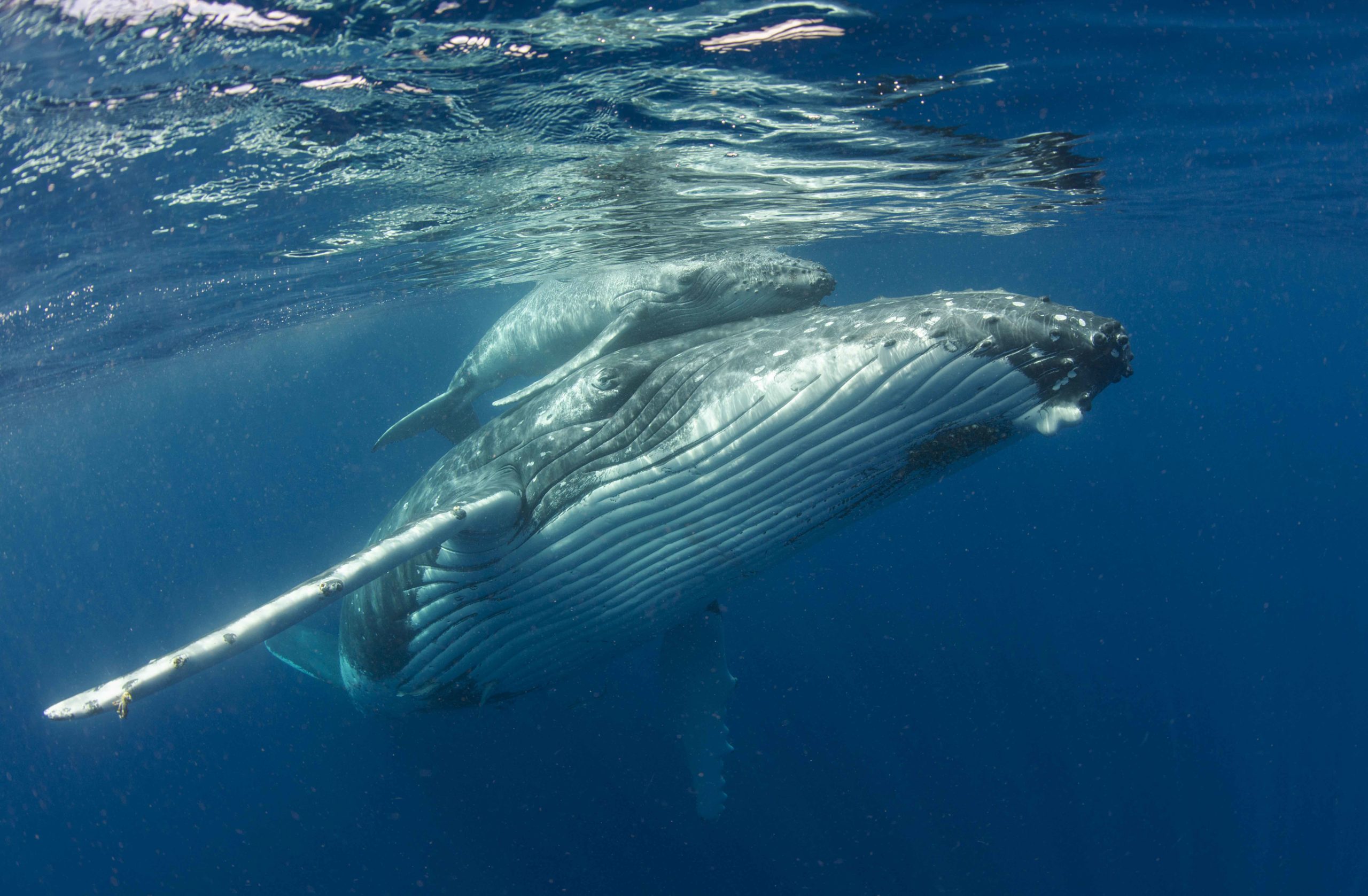
Iconic Species that Roadtrip in our National Marine Sanctuaries
Imagine walking thousands of miles to get to your winter vacation destination instead of taking a plane, train, or automobile. It might sound exhausting to you, but this is what life is like for migratory animals that make seasonal trips between their summer and winter habitats. Here are some of the most exceptional migrations that occur throughout the National Marine Sanctuary System.
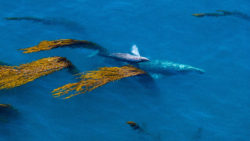
A gray whale mother and her calf swimming through a kelp forest in Monterey Bay National Marine Sanctuary. Photo: Douglas Croft
Gray Whales (Eschrichtius robustus) make the longest migration of any mammal on earth. Their summer feeding grounds are in the cool waters of the Bering, Chukchi, and Beaufort seas near Alaska, where they feed and build fat stores for the winter. Their winter breeding and nursing grounds are off the coast of Baja California Sur, where they nurse their calves before returning north for the summer to teach them how to hunt for themselves. The total distance between their habitats is around 6,000 miles, meaning these animals swim 12,000 miles round trip each year!
Gray whales begin their migration south in October, passing near or through all of America’s west coast marine sanctuaries, including Olympic Coast, Greater Farallones, Monterey Bay, Cordell Bank, and Channel Islands. In March, they begin their journey north and again pass through or by these same sanctuaries. They are often visible from shore, giving whale enthusiasts the opportunity to see or follow them along on their journeys! Whale watching operators in California also offer special gray whale excursions between January and March.
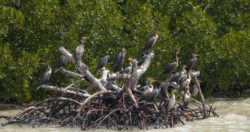
Cormorants hanging out on mangroves trees in Florida Keys National Marine Sanctuary. Photo: David J. Ruck/NOAA
Migratory shorebirds are common throughout the National Marine Sanctuary System and are a favorite of people who enjoy viewing wildlife. Gray’s Reef National Marine Sanctuary off the coast of Georgia and Channel Islands National Marine Sanctuary off Southern California’s coast are two examples of sanctuaries where migratory bird sightings are common.
In March, migratory shorebirds returning north from their winter nesting habitats visit Georgia’s coastal and offshore water including Gray’s Reef to feed on the plentiful bait fish that live in the area. This pit stop helps them build up their energy reserves to continue their journey northward to their nesting grounds in the northeastern United States and Canada.
The Channel Islands region is also a common spot for migratory birds, many of which use areas on the islands for nesting and feeding. Some examples include:
Brant Geese (Branta bernicla) which stop to feed and rest on their annual migration between Mexico and Alaska from March through May
Western Gulls (Larus occidentalis) and double-crested cormorants (Phalacrocorax auritus) begin nesting on the Channel Islands in March and April
Xantus’s Murrelets (Synthiboramphus hypoleucus) breed and nest on the Channel Islands between March and July
In April, hawk migration begins at Cape Flattery down to the south. Endangered Least Terns (Sterna antillarum browni) travel through the Channel Islands Region between May and late-August
Pink-Footed Shearwaters (Puffinus creatopus), Sooty Shearwaters (Puffinus griseus), Ashy Storm-Petrels (Oceanodroma homochroa), and Black Storm-Petrels (Oceanodroma melania) can be seen in the Santa Barbara Channel between May and early October
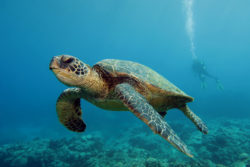
Green sea turtle spotted in Hawaiian Islands Humpback Whale National Marine Sanctuary. Photo: Bill Pigott
Sea turtles migrate seasonally between their nesting and foraging habitats, travelling hundreds or thousands of miles at a time. Since they are cold blooded animals, they travel as water temperatures change to avoid cold stress, a form of hypothermia that occurs when waters are too cold for too long. In May, female loggerhead turtles (Caretta caretta) come ashore on Georgia’s barrier islands to dig their nests and lay approximately 120 eggs per nest. The turtles spend time in Gray’s Reef National Marine Sanctuary foraging for crabs, sponges, small fish, and jellyfish. They also rest under the sandstone ledges on shore. The eggs begin hatching in the summer and continue to do so through October. In the Atlantic, they will travel from the Caribbean to the East Coast and northward to Canada. In the Pacific, they usually travel from Southeast Asia to California and northward to Alaskan waters.
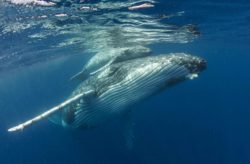
Humpback whale in Tonga. Photo: Jayne Jenkins/ Coral Reef Image Bank
Humpback whales (Megaptera novaeangliae) are faithful to their annual feeding and calving grounds. On the east coast, humpback whales spend their summers in the northeast, including in Stellwagen Bank National Marine Sanctuary, where they feed on sand lance and other small fish and crustaceans. This population begins its winter migration in late-October as the whales head to islands in the Caribbean to mate and give birth, a trek of nearly 1,500 miles. On the west coast, humpback whales summer near Alaska and Canada and spend the winters in Hawaiian Islands Humpback Whale National Marine Sanctuary. On their journey north – between May and August – humpback whales will feed in the rich, upwelled waters of Channel Islands National Marine Sanctuary. Humpback whale watching is a popular activity along America’s east and west coasts, and anyone can volunteer for the annual Sanctuary Ocean Count in Hawai’i, where data collected can help scientists understand the population health of these whales and changes in their routes or behaviors.
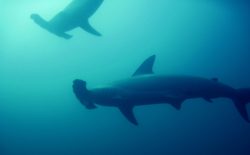
Two hammerhead sharks off the coast of Gray’s Reef National Marine Sanctuary. Photo: Mitchell Tartt/NOAA
Great Hammerhead Sharks (Sphyrna mokarran) are solitary but highly migratory animals. They can migrate long distances of more than 756 miles, which is incredible for a fish. From January to early April, these animals school in Flower Garden Banks National Marine Sanctuary in the Gulf of Mexico. In March, scallop hammerhead populations peak in Flower Garden Banks and visitors may see large schools of them. They then return to waters in the Caribbean and the Atlantic. During the summer months, they will migrate polewards to seek cooler waters.
